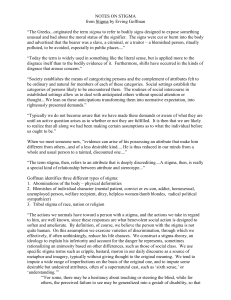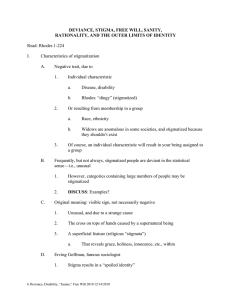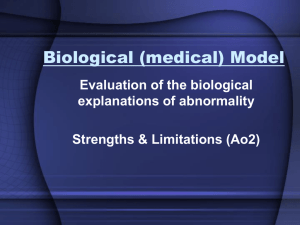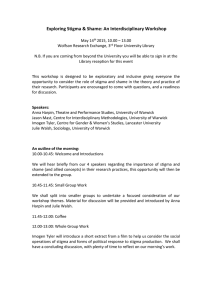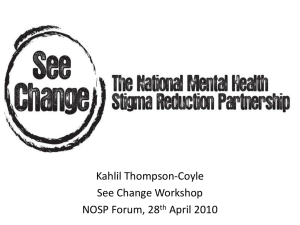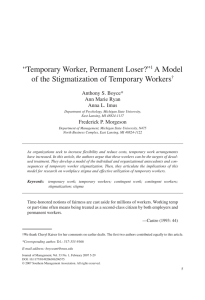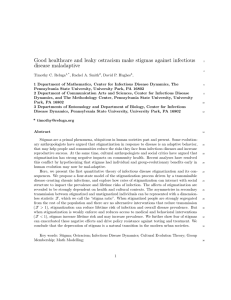Read: Waxler: Learning to be a leper: a case... Farquhar: Market magic: getting rich and getting personal in medicine... Stigmatized Conditions: Responsibility and Blame
advertisement
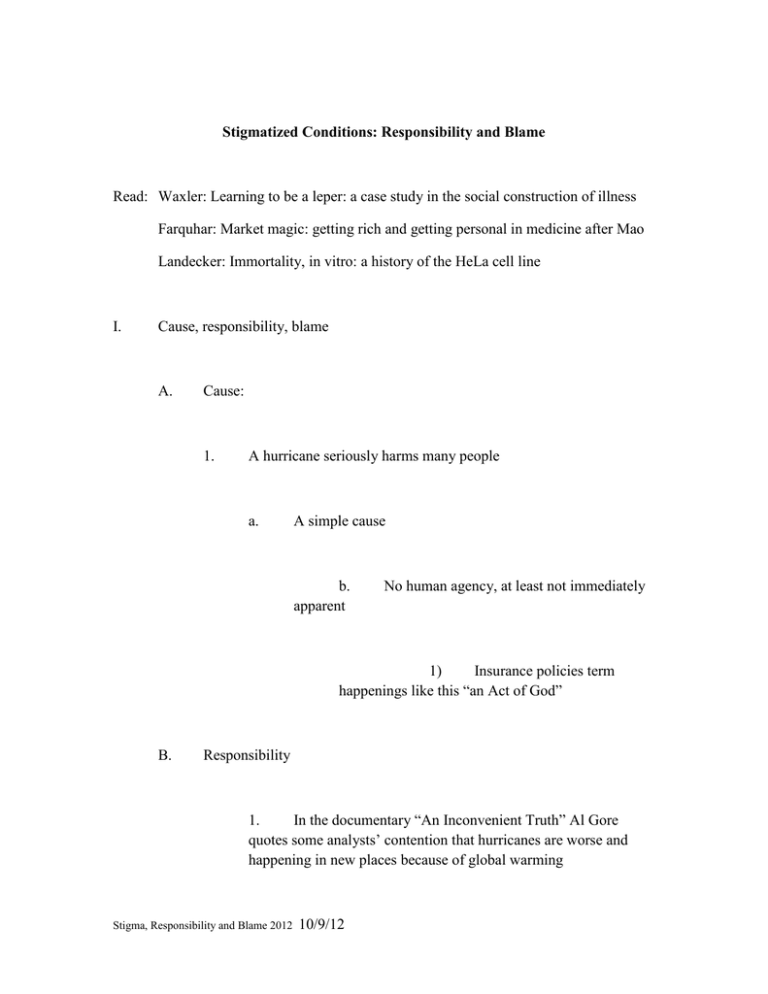
Stigmatized Conditions: Responsibility and Blame Read: Waxler: Learning to be a leper: a case study in the social construction of illness Farquhar: Market magic: getting rich and getting personal in medicine after Mao Landecker: Immortality, in vitro: a history of the HeLa cell line I. Cause, responsibility, blame A. Cause: 1. A hurricane seriously harms many people a. A simple cause b. apparent No human agency, at least not immediately 1) Insurance policies term happenings like this “an Act of God” B. Responsibility 1. In the documentary “An Inconvenient Truth” Al Gore quotes some analysts’ contention that hurricanes are worse and happening in new places because of global warming Stigma, Responsibility and Blame 2012 10/9/12 a. Here there is agency—human beings making choices b. Cause? Responsibility? Blame? 2. Think of debates about people with HIV/AIDS: the stereotype of drug users, homosexuals, promiscuous sex a. Then think about people who contracted HIV through blood transfusions b. 3. C. Cause? Responsibility? Blame? DISCUSS: what does Farmer often suggest about this issue? Blame 1. DISCUSS: would Typhoid Mary’s causing many cases of typhoid by being a carrier put her into the “cause” category, the “responsible” category, or the “blame” category? 3 a. One answer: she had poor personal hygiene, so she was responsible, but she was not to blame 4 2. A misanthropic prostitute in Florida knowingly tried to transmit HIV, tried to kill several men, and she succeeded 3. Or the case of a young man in New York state who infected a number of teenage girls; he knew he was HIV positive, still didn’t practice safe sex D. Early in the AIDS epidemic: very revealing public reactions to hemophiliacs, dental patients, little boys contracting HIV 1. Ryan White, an infected child, was not allowed to attend school a. Poor understanding of the disease at that b. Great fear of contagion time 2. Farmer: a. Haitians “4-H”: Hemophiliacs, Heroin, Homosexuals, 1) All highly stigmatized 2) Regardless of degree of responsibility or blame attributed to them 5 II. Stigma A. A process of categorization and generalization 1. People who share a characteristic feature1—whatever elicits stigmatization) 2. Are lumped into a group and are seen to share certain other basic personal characteristics as well 3. Fairly superficial features are seen to indicate more fundamental traits that lead to deviant behavior or deficiencies of character 4. Religious “stigmata”: the classic prototype of stigma involves a superficial feature a. Revealing grace, holiness, innocence, etc., within B. Stigma is an extreme form of categorical inference: it often “engulfs” the identity of the individual, because the objectionable characteristics attributed become highly salient 1 Sociologist Erving Goffman wrote the classic Stigma: Notes on the Management of Spoiled Identity. Englewood Cliffs, N.J.: Prentice-Hall, 1963. 6 C. For the most part, stigma is accompanied by very negative affect on the part of the stigmatizers 1. Not always: remember my mentioning Montezuma’s reported use of people with pinta (a cousin of yaws, a distant cousin of syphilis), as his personal guard? a. But we might not call this stigma The affect elicited may be more complex than simple 2. negative reactions a. Sometimes fascination appears—there may not be a feeling of abhorrence at all 1) D. Little children will react this way DISCUSS: classic stigma examples? 1. Race, ethnicity 2. Disease, disability a. In reality many stigmatized ill people have problems that are anything but superficial E. Classic stigma: 7 1. Visible features are seen to be an index of (to point to) the presence of more fundamental, invisible traits that produce deviant behavior or deficiencies of character a. All the criminals in the newspaper comic “Dick Tracy” are depicted as having a physical defect 2. Quite often the reaction is complex a. Stigmatizers know they should feel pity 1) Although sometimes individuals who are stigmatized say they don’t want people’s pity, just equal treatment and respect, if possible b. Or stigmatizers realize that some of this process is arbitrary and inappropriate 1) They realize that there simply is not enough evidence for their negative reactions c. So, if guilt and sympathy mingle, the very common emotion accompanying stigmatizing processes— ambivalence—appears d. individuals Pornography that depicts disabled, obese 8 1) Is playing with extremes and shock, seeking to invert what ordinarily is attractive 2) III. So, the reaction might be a blend of fascination with repulsion Four perspectives have been taken in social science to analyze stigma A. The first examines how stigmatized people manage and cope B. The second looks at self-fulfilling prophecy mechanisms, known as social labeling The very act of putting a person into the category can result 1. in that person being perceived to be like other members of the category 2. These scholars also look at “secondary deviance” in which the targets of stigmatizing come to behave in deviant fashion as a result of the labeling a. 3. “Living up to their reputation” Rosenhan et al. provide an example of social labeling 9 C. The third: stigma is analyzed as a mechanism of social control: stigmatized people serve as a warning, an encouragement to others to stay in line 1. D. By illustrating the dire consequences of not doing so The fourth: the “just world” hypothesis: that accidents or illnesses don’t “just happen” 1. You must have done something wrong a. The criminals in the Dick Tracy comics demonstrate this idea 2. Stigmatization processes will target people whose appearance or behavior a. Is seen to be a challenge to prevailing definitions of the social order 3. This targeting is not considered a conscious process 4. Those subjected to the stigmatizing process are seen as a threat to community well-being a. Even though the threat is symbolic, not real 10 5. The credibility of such reasoning is established by convincingly demonstrating the links between the person bearing the mark and danger a. E. DISCUSS: Haitain examples? The last two approaches (“just world” and “social control”) are based on the assumption that stigmatization achieves social purposes These explanations are “functionalist” because they argue 1. that a behavior exists because it serves some kind of purpose a. 1) b. Psychological “functionalist” explanations DISCUSS: examples? And social ones 1) Example: stigmatizing behavior affirms the values of the in-group 2) Displays the in-group’s superiority 3) Enhances its solidarity 4) Affirms its power—to define, to exclude, to punish 11 IV. Chronic pain and stigma A. Many of the patients I interviewed reported feeling stigmatized 1. B. It’s interesting because pain is invisible We have to conclude that chronic pain itself is not stigmatized 1. Because pain is not associated with any deviant behavior or appearance or invisible quality that the people engaging in stigmatizing behavior can link directly to a diagnosis—as happens in leprosy or AIDS a. Tom Hanks in the movie “Philadelphia”— his outward signs of AIDS elicited shunning b. DISCUSS: Waxler’s discussion of the consequences of stigma in leprosy cases? C. With pain, it is the reactions of others to a pain sufferer’s behavior that produce stigmatization D. Why? Some possible reasons: 1. Chronic pain is often seen as not quite a “real” illness 12 a. First of all, it’s chronic b. Insofar as our core concept of illness is that it either kills or eventually goes away, chronic illnesses aren’t quite legitimate conditions 2. Pain is mysterious: in this person it doesn’t go away—yet we’ve all experienced pain, and it has gone away 3. Mind/body overlap 4. Severe pain is a threatening thought a. Hell is severe chronic pain, if you think about it 5. So, the conclusion is drawn that chronic pain sufferers shouldn’t be/couldn’t be experiencing so much pain a. Despite everyone’s knowledge that there are long-lasting conditions that produce pain, like arthritis A second sub-conscious conclusion: that someone in pain 6. shouldn’t show it after a while (because pain usually goes away) a. This constitutes a dilemma for sufferers: because pain is invisible, they must periodically show it with gestures or indicate it with speech, or people will forget they have it 13 7. Another sub-conscious conclusion: pain sufferers don’t deserve compensation a. Maybe they’re deadbeats, scamming b. The idea that a benefit from being ill keeps a person ill is called “secondary gain” 8. A process of “blame the victim” occurs a. One possible explanation: personality defects: “You’re making a mountain out of a molehill” Or secondary gain: “you’ve got it good, b. you’re getting all this attention, not having to work” c. Or the explanation is that the pain sufferer’s neurosis is keeping him/her from getting better MIT OpenCourseWare http://ocw.mit.edu 21A.215 Disease and Health: Culture, Society, and Ethics Spring 2012 For information about citing these materials or our Terms of Use, visit: http://ocw.mit.edu/terms.

